Argoños is flat, of fertile soil and riberbanks with strong tides, changing the scennery constantly.
The estuary has a high level of ecological ecosystems, protected by the Santoña. Victoria and Joyel Marshes Nature Park.
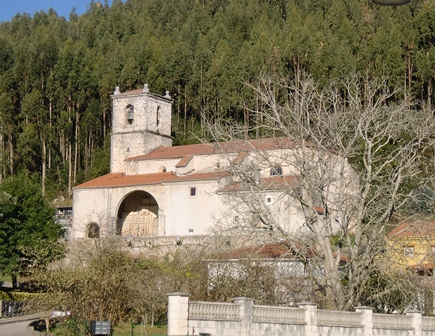 San Salvador Church
San Salvador Church
It is the most important religious building of Argoños, situated at the foot of the mount Brusco, almost hidden inbetween cipress, ashes and a millenary chesnut. It dates back to the XVI century, refurbished and extended during the XVII century. It is formed by one nave. On the outside a classicist door and two coats of arms. One of them, on the left wall, belongs to the Jado family, the most interesting in the village. Opposite, the one belonguing to the Venero family, with the King knighting a vassal.
See on map
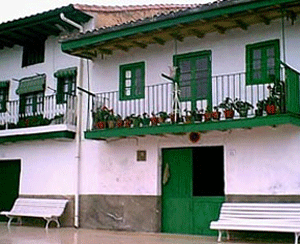 Trasmeran ensemble
Trasmeran ensemble
It mantains the lineup of fishermen houses, white washed, with wooden balconies. They date back to the end of the XVIII century and beginning of the XIX. In addition, we can visit the Chapel of San Esteban: It was built in the XVII century and later refurbished.
See on map
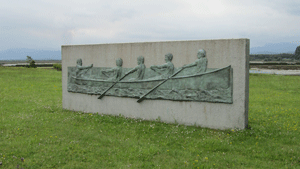 Monument to the Skiff
Monument to the Skiff
Made to honour the rowers of Argoños who were cahmpions of Spain in 1972 in this modality. The monument was placed in March 2011. The skiff is a small rowing vessel, propelled by four rowers and a captain.
See on map
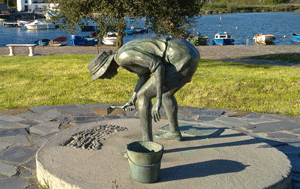
mariscador
Monument to the gatherer of shellfish
Situated in the Ancillo neighbourhood in honour to the gathering of shellfish tradition in the locality, built in 2005.
See on map
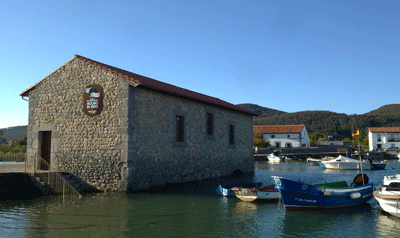 Ancillo Tidemill
Ancillo Tidemill
It is a tidemill, using the sea tides energy, it grinded cerelas. This was achieved by building a wall in an estuary that allowed the water in through the movement of the tides by channels and actioning the blades on the hydrolic wheels, generating a rotating movement in the engine. This mills spreaded out through all the estuaries of the Cantabrian coast during the XVII century, to grind corn. The best preserved example is the Jado tidemill: It shows naval models respresenting the Argoños skiff, and an information centre of the marshes, the fishing traditions of the area and a demonstration of the mill functioning. It is a 45 minutes visit and consists of four parts: the function of the mill, the arts of fishing and gathering shellfish, history and evolution of the boat and general information of Argoños.
Visits: The mill functions depending on the tides. This is why we recommend calling before visiting (10 people minimum).
Telephone: 663.80.43.87 ; 942.62.60.25
See on map
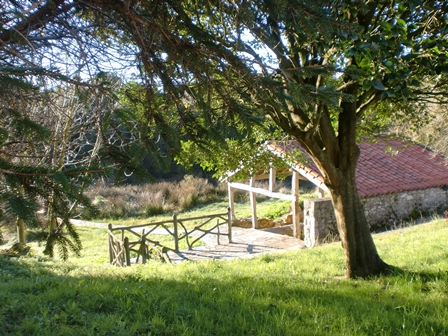 The old washing place
The old washing place
This washing place is situated at the rear of the estuary and uses the emergence of water. Many of these washing places were built between the end of the XIX century and beginning of the XX century and they stopped functioning around 25 to 30 years ago, the main reason being the introduction of running water in houses.
See on map

San Salvador Church
It is the most important religious building of Argoños, situated at the foot of the mount Brusco, almost hidden inbetween cipress, ashes and a millenary chesnut. It dates back to the XVI century, refurbished and extended during the XVII century. It is formed by one nave. On the outside a classicist door and two coats of arms. One of them, on the left wall, belongs to the Jado family, the most interesting in the village. Opposite, the one belonguing to the Venero family, with the King knighting a vassal.
See on map
It is the most important religious building of Argoños, situated at the foot of the mount Brusco, almost hidden inbetween cipress, ashes and a millenary chesnut. It dates back to the XVI century, refurbished and extended during the XVII century. It is formed by one nave. On the outside a classicist door and two coats of arms. One of them, on the left wall, belongs to the Jado family, the most interesting in the village. Opposite, the one belonguing to the Venero family, with the King knighting a vassal.
See on map

Trasmeran ensemble
It mantains the lineup of fishermen houses, white washed, with wooden balconies. They date back to the end of the XVIII century and beginning of the XIX. In addition, we can visit the Chapel of San Esteban: It was built in the XVII century and later refurbished.
See on map
It mantains the lineup of fishermen houses, white washed, with wooden balconies. They date back to the end of the XVIII century and beginning of the XIX. In addition, we can visit the Chapel of San Esteban: It was built in the XVII century and later refurbished.
See on map

Monument to the Skiff
Made to honour the rowers of Argoños who were cahmpions of Spain in 1972 in this modality. The monument was placed in March 2011. The skiff is a small rowing vessel, propelled by four rowers and a captain.
See on map
Made to honour the rowers of Argoños who were cahmpions of Spain in 1972 in this modality. The monument was placed in March 2011. The skiff is a small rowing vessel, propelled by four rowers and a captain.
See on map

mariscador
Monument to the gatherer of shellfishSituated in the Ancillo neighbourhood in honour to the gathering of shellfish tradition in the locality, built in 2005.
See on map

Ancillo Tidemill
It is a tidemill, using the sea tides energy, it grinded cerelas. This was achieved by building a wall in an estuary that allowed the water in through the movement of the tides by channels and actioning the blades on the hydrolic wheels, generating a rotating movement in the engine. This mills spreaded out through all the estuaries of the Cantabrian coast during the XVII century, to grind corn. The best preserved example is the Jado tidemill: It shows naval models respresenting the Argoños skiff, and an information centre of the marshes, the fishing traditions of the area and a demonstration of the mill functioning. It is a 45 minutes visit and consists of four parts: the function of the mill, the arts of fishing and gathering shellfish, history and evolution of the boat and general information of Argoños.
Visits: The mill functions depending on the tides. This is why we recommend calling before visiting (10 people minimum).
Telephone: 663.80.43.87 ; 942.62.60.25
See on map
It is a tidemill, using the sea tides energy, it grinded cerelas. This was achieved by building a wall in an estuary that allowed the water in through the movement of the tides by channels and actioning the blades on the hydrolic wheels, generating a rotating movement in the engine. This mills spreaded out through all the estuaries of the Cantabrian coast during the XVII century, to grind corn. The best preserved example is the Jado tidemill: It shows naval models respresenting the Argoños skiff, and an information centre of the marshes, the fishing traditions of the area and a demonstration of the mill functioning. It is a 45 minutes visit and consists of four parts: the function of the mill, the arts of fishing and gathering shellfish, history and evolution of the boat and general information of Argoños.
Visits: The mill functions depending on the tides. This is why we recommend calling before visiting (10 people minimum).
Telephone: 663.80.43.87 ; 942.62.60.25
See on map

The old washing place
This washing place is situated at the rear of the estuary and uses the emergence of water. Many of these washing places were built between the end of the XIX century and beginning of the XX century and they stopped functioning around 25 to 30 years ago, the main reason being the introduction of running water in houses.
See on map
This washing place is situated at the rear of the estuary and uses the emergence of water. Many of these washing places were built between the end of the XIX century and beginning of the XX century and they stopped functioning around 25 to 30 years ago, the main reason being the introduction of running water in houses.
See on map




